Cubical World
환원 가능한 복잡성을 지닌 쥐덫 본문
환원 가능한 복잡성을 지닌 쥐덫
존 H. 맥도날드
생명과학과
델라웨어 대학교
Creationist Michael Behe attracted a lot of attention with his advocacy of the "intelligent design" argument. He makes the claim that certain biochemical processes are "irreducibly complex": they involve multiple proteins, and removing any one of them would destroy the function of the overall pathway. From this he concludes that these pathways could not have evolved through the action of natural selection, but instead must have been created by an "intelligent designer."
창조설자 마이클 베히는 "지적설계" 논쟁에서 본인이 행한 변호를 통해 많은 관심을 얻었다. 그는 특정한 생화학적 과정은 "환원 불가능한 복잡성"을 보인다고 주장한다. 그러한 류의 과정에는 다수의 단백질이 연관되어 있으며, 그 중 단 하나라도 과정에서 제외시킨다면 전체적인 경로의 기능이 무너진다는 것이다. 이로부터 그는 이러한 경로들은 자연선택을 통해 진화했을 수 없으며, "지적 설계자"에 의해 창조되었으리라고 결론짓는다.
To illustrate the concept of irreducibly complexity, Behe uses the common snap mousetrap. "If any one of the components of the mousetrap (the base, hammer, spring, catch, or holding bar) is removed, then the trap does not function. In other words, the simple little mousetrap has no ability to trap a mouse until several separate parts are all assembled. Because the mousetrap is necessarily composed of several parts, it is irreducibly complex." (Behe, 1996).
환원 불가능한 복잡성의 개념을 설명하기 위해 베히는 일반적인 쥐덫을 예시로 든다. "쥐덫의 요소(나무판자, 해머, 스프링, 걸쇠나 금속막대1) 중 단 하나라도 제거된다면, 쥐덫은 제 역할을 해내지 못한다. 다르게 말하자면, 간단하고 작은 쥐덫은 여러 독립된 부품들이 전부 조립되지 않는 이상 쥐를 잡을 능력이 없다. 쥐덫은 필연적으로 여러 부품으로 구성되어 있기 때문에, 환원 불가능하게 복잡하다." (베히, 1996).
It is not my purpose here to point out all of the philosophical flaws in Behe's argument; this has been done thoroughly elsewhere (see Talk Origins and Talk Design to get started into the literature). Instead, I wish to point out that the mousetrap that Behe uses as an analogy CAN be reduced in complexity and still function as a mousetrap. The mousetrap illustrates one of the fundamental flaws in the intelligent design argument: the fact that one person can't imagine something doesn't mean it is impossible, it may just mean that the person has a limited imagination. Behe's evidence that biochemical pathways are intelligently designed is that Behe can't imagine how they could function without all of their parts, but given how easy it is to reduce the complexity of a mousetrap, I'm not convinced. (Of course, the reduced-complexity mousetraps shown below are intended to point out one of the logical flaws in the intelligent design argument; they're not intended as an analogy of how evolution works.)
베히의 주장에 있는 모든 철학적인 헛점을 짚어내는 것이 내 의도는 아니다. 그러한 일은 다른 곳(Talk Origins나 Talk Design을 참조할 것)에서 진행되고 있다. 그 대신, 난 베히가 비유로 든 쥐덫이 복잡성을 감소시키고도 여전히 쥐덫으로 기능하는 것이 가능하다는 것을 짚고 넘어가고자 한다. 이 쥐덫은 지적설계의 근본적인 헛점 중 하나를 나타낸다. 한 개인이 무언가를 상상해내지 못한다고 해서 그것이 불가능한 것은 아니며, 그 사람이 제한된 상상력을 가지고 있다는 것을 의미할 수도 있다는 사실 말이다. 생화학적 경로가 지적인 존재에 의해 설계되었다는 주장에 대한 베히의 증거는 베히가 모든 부품들이 없어도 어떻게 경로가 기능할 수 있는지를 상상할 수 없다는 것이나, 쥐덫의 복잡성을 감소시키는 것이 얼마나 간단한지로 미루어보아 그닥 신빙성 있는 증거로 다가오지는 않는다.(물론, 아래에 보일 복잡성이 감소된 쥐덫들은 지적설계의 논리적 헛점 중 하나를 짚어내기 위해 의도된 것이다. 진화가 어떻게 작용하는지에 대한 비유가 아니다.)
My original reduced-complexity mousetraps must have struck a nerve, since Behe later added a web page lengthy "rebuttal" of them to his webpage. I find his objections muddled and confusing, but he seems to be saying that showing how something would work after removing some parts is not enough to reject irreducible complexity; it is necessary to show how something could be built up, step by step, with each addition or modification of a part improving the function. This seems to go beyond the original definition ("necessarily composed of several parts"), but I have merely taken it as a challenge. Here I show how one could start with a single piece of spring wire, make an inefficient mousetrap, then through a series of modifications and additions of parts make better and better mousetraps, until the end result is the modern snap mousetrap. In addition to demonstrating that a mousetrap is not irreducibly complex, I also illustrate the most important objection to "irreducible complexity" as evidence for "intelligent design": a part which may be optional at one stage of complexity may later become necessary due to modifications of some of the other parts.
내가 전에 작성했던 환원 가능한 복잡한 쥐덫에 관한 글이 베히의 신경을 건드린 것 같다. 나중에 그가 본인의 웹페이지에다가 내 글에 대한 긴 "반박문"을 게시한 것으로 보아 말이다. 난 그의 반박문이 뒤죽박죽이고 혼란스럽다는 인상을 받았으나, 베히는 몇 가지 부품을 제거하더라도 무언가가 제대로 작동한다는 것을 보이는 것으로 환원 불가능한 복잡성이라는 개념을 퇴출시키기에는 불충분하다고 주장하는 것으로 보인다. 그보다는 무언가가 어떻게 차례 차례, 한 부분이 추가되거나 수정될 때마다 기능이 향상되면서, 완성되가는지를 보여주는 것이 필요하다고 보는 것 같다. 이는 기존의 정의("필연적으로 여러 부품으로 구성되어있기 때문에")에서 벗어나는 것으로 보이지만, 난 단순히 이를 도전으로 받아들였다. 여기서 나는 스프링 철사 한 가닥에서부터 시작하여, 비효율적인 쥐덫을 만들고, 일련의 부품 추가 및 수정을 통해 계속해서 더 나은 쥐덫을 만들어가며, 최종 결과물이 현대적인 쥐덫이 되는지를 보여줄 것이다. 그리고 쥐덫이 환원 불가능한 복잡성을 가진 것이 아니라는 사실을 보여주면서, "지적 설계"에 대한 근거로의 "환원 불가능한 복잡성"에 가장 중요한 반론을 제기할 것이다. 한 단계의 복잡성에서는 선택적인 것 처럼 보였던 부품이 나중에는 다른 부품들에 수정을 가하면서 필요해지는 상황을 말이다.
A completely different series of mousetraps in various stages of complexity has been designed by Alex Fidelibus.
알렉스 피델리버스가 여러 단계의 복잡성에서 완전히 다른 일련의 쥐덫들을 디자인하였다.
A recent article by Joachim Dagg (Dagg, J. 2011. Exploring mouse trap history. Evolution: Education and Outreach) reviews the history of actual mousetraps, showing that they did indeed "evolve" from simple to more complex through time, including mousetraps that were similar to the modern snap mousetrap but had fewer parts.
요아킴 다그(Joachim Dagg)는 본인의 최근 논문(Dagg, J. 2011. Exploring mouse trap history. Evolution: Education and Outreach)에서는 실제 쥐덫의 역사를 되새기며, 시간이 지나면서 쥐덫이 실제로 간단한 구조에서 복잡한 구조로 "진화"했음을 보였다. 여기에는 현대의 쥐덫과 비슷하나 부품의 수는 더 적은 쥐덫들도 있었다.
(This page has been translated into Romanian by Jan Rolsky, developer of a free mp4 converter).
(이 페이지는 무료 mp4 변환기의 개발자이기도 한 Jan Rolsky에 의해 루마니아어로 번역되었습니다).
(If the "Animate" buttons don't make the pictures move, make sure your browser has Javascript enabled.)
(만약 아래에서 "재생" 버튼이 먹히지 않는다면, 브라우저에서 자바스크립트가 허용되어있는지 확인해주세요.)
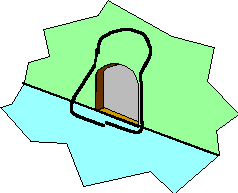
I'll start with a piece of springy wire, bent so that it can be held open by carefully positioning one end of the wire against the other. If an unlucky mouse steps on the trap and dislodges the ends, the trap closes. Most mice knock the trap over rather than sticking their necks through it, and the spring is so weak that some mice wriggle out before they die, so it's not a very good trap. Still, it's better than having no trap at all.
탄성있는 철사 한 조각으로 시작하도록 하겠다. 이 철사는 한쪽 끝을 다른쪽 끝에 조심스럽게 올려놓는 것으로 열려있을 수 있도록 굽어져 있다. 만일 불운한 쥐 한 마리가 덫에 발을 들여놓아 철사의 양 끝이 제자리에서 벗어나게 된다면, 덫이 닫힐 것이다. 대부분의 쥐들은 덫에다가 제 목을 들여놓기보다는 함정을 넘어뜨릴 것이고, 스프링 자체가 약해서 어떤 쥐들은 죽기 전에 빠져나올 수도 있을 것이기에, 그다지 좋은 덫은 아니다. 그렇지만, 아무런 덫도 없는 것 보다는 여전히 낫다.
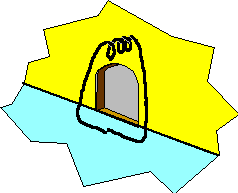
Adding a coil to the previous trap makes the trap close with more force. Every coil that is added makes the trap close with greater force, increasing the proportion of mice that get killed.
전의 덫을 감는 것으로 덫은 더 큰 힘으로 닫히게 되었다. 한 번 감을 때마다 덫은 더 큰 힘으로 닫히게 되며, 잡히는 쥐의 비율을 증가시킨다.
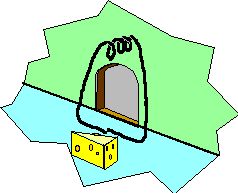
Adding bait makes the trap more efficient by attracting more mice to it. Bait is an optional part of all of the traps shown here; all of these traps would catch mice that happened to stumble into them.
덫에다가 미끼를 추가시키는 것으로 더 많은 쥐를 끌어들일 수 있게 된다. 미끼는 여기서 보이는 모든 덫의 부가적인 요소이다. 미끼가 없더라도 어쩌다가 발이 걸리게 된 쥐를 잡을 수 있기 때문이다.
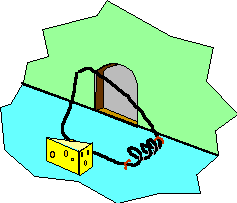
The previous traps need to be carefully propped against a wall or other object, which limits the places they can be used and lets mice knock the trap over. Attaching the spring to the floor with one or two staples increases the usefulness of the trap, because it can now be used anywhere the floor is wooden, and mice won't knock it over. The staples are optional at this point.
이 전의 덫들은 벽이나 다른 사물로 조심스럽게 받치고 있어야했기에 사용할 수 있는 장소가 제한되며, 쥐가 덫을 넘어뜨릴 수도 있었다. 스테이플러 심 한 두개로 스프링 부분을 바닥에 고정시키는 것으로 덫의 유용성이 증가했다. 바닥이 나무이기만 하다면 어디에라도 설치할 수가 있고, 쥐가 넘어뜨리지도 못할 것이기 때문이다. 이 시점에서 스테이플러 심은 부가적인 요소이다.
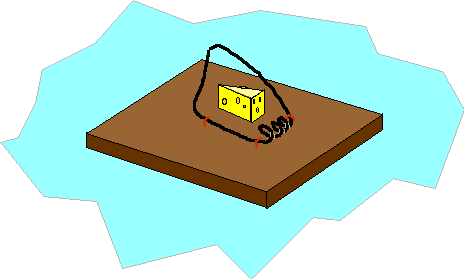
Attaching the spring to a piece of wood is even better, since it's easier to move around, doesn't leave holes in the floor, and can be used on concrete floors. The wooden platform and the staples are optional, though; the trap would still work with just the spring.
스프링을 나무판자에 붙이는 것은 더 좋다. 옮기기도 쉽고, 바닥에 구멍이 나지도 않으며 콘크리트 바닥에서도 사용이 가능하기 때문이다. 그렇지만 나무 판자와 스테이플러 심은 부가적인 요소들이다. 스프링만 있어도 덫은 작동할 것이기 때문이다.
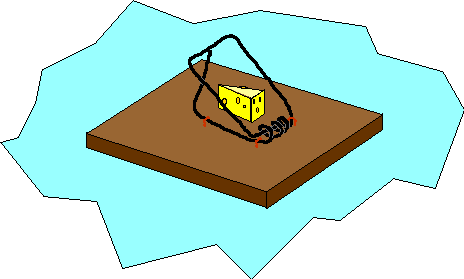
Making the swinging end of the wire (the "hammer") longer increases the chance that it will hit a mouse, so as it gradually goes from I-shaped to L-shaped to U-shaped, it gradually becomes more effective. The free end of a U-shaped hammer might flex enough that it wouldn't crush all mice; tucking it into the coils of the spring improves on this.
철사의 흔들리는 한 쪽 끝("해머")의 길이를 늘이는 것은 그게 쥐를 칠 확률을 높인다. 따라서 해머는 서서히 I자에서 L자로, 또 U자로 바뀐다. 그 쪽이 더 효율적이기 때문이다. U자 해머의 자유로운 한 쪽 끝이 쥐를 박살낼 수 없을 정도로 잘 휘어진다면, 철사를 감은 부분에 해당 부분을 집어넣는 것으로 개선이 가능하다.
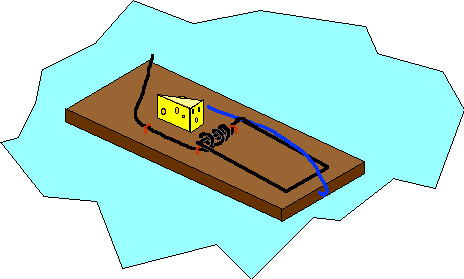
The previous trap had the hammer propped up on a vertical piece of wire. This must be done very precisely, so that a mouse brushing against the vertical piece of wire will dislodge the hammer. Adding another piece of wire as a hold-down bar makes it easier to set the trap and easier for a mouse to trip it. One end of the hold-down bar is jammed into the end of the wooden platform, while the other end is hooked under the corner of the hammer. When a mouse nudges the hold-down bar, dislodging it from the corner of the hammer, it releases the hammer. Because the hold-down bar is a lever, it holds the hammer down with much less force and therefore requires less force to dislodge.
이전의 덫에서는 해머는 수직으로 서 있는 철사가 떠받치고 있었다. 이는 쥐가 수직으로 선 철사에 닿아 해머가 제자리에서 벗어나는 일이 없도록 아주 정확하게 놓여야 한다. 꺾쇠의 역할을 할 또 다른 철사를 더하는 것으로 덫을 설치하는 것도 쉬워지고, 쥐가 덫을 작동시키는 것도 더 쉬워졌다. 꺾쇠의 한쪽 끝은 나무판자의 모서리에 박혀있고, 다른쪽 끝은 해머의 귀퉁이에 걸려있다. 만약 쥐가 꺾쇠를 건드려, 해머의 귀퉁이에서 빼낸다면, 해머가 작동한다. 꺾쇠는 지렛대로써 작용하기에, 해머를 훨신 적은 힘으로 누르고 그에 따라 덫을 작동시키는데 훨씬 적은 힘이 필요하다.
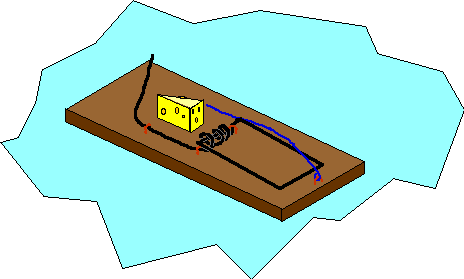
The base of the previous trap will eventually get splintered where the hold-down bar is jammed into it. Using a staple to hold the end of the hold-down bar increases the useful life of the mousetrap.
이전의 덫의 판자는 꺾쇠가 박혀있는 부분이 결국에는 갈라지고 말 것이다. 꺾쇠의 한쪽 끝을 스테이플러 심으로 고정시킴으로써 쥐덫의 수명을 연장시킬 수 있다.
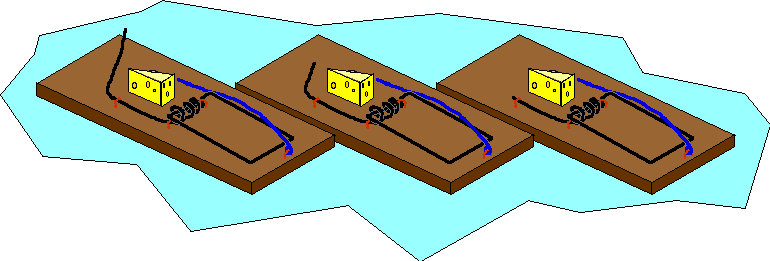
With the hold-down bar in use, the vertical part of the spring wire is unnecessary and maybe even in the way. Shortening it saves wire, making the trap less costly. This modification has some dramatic side effects, though. Now the hold-down bar and the staples are necessary parts of the trap, rather than just optional improvements. Take away the hold-down bar or the staples, and this version of the trap would not catch any mice. This is an analogy for the way that an initially optional protein in a biochemical pathway later could become necessary to the function of the pathway, due to adaptative modification of other enzymes.
꺾쇠를 사용함으로써 철사의 수직으로 선 부분은 불필요하게 되었고 심지어는 작동을 방해할 수도 있다. 이 부분을 짧게 하여 철사도 아끼고, 쥐덫을 만드는 비용도 절감할 수 있다. 그러나 이렇게 변경하는것으로 조금 극적인 부작용이 생길수도 있다. 이제 꺾쇠와 스테이플러 심은 부가적인 요소가 아니라 필수적인 부분이 되었다. 만약 꺾쇠나 스테이플러 심을 제거한다면, 이 쥐덫은 쥐를 잡지 못할 것이다. 이것은 생화학적 회로에서 처음에는 부가적이었던 단백질이 이후 다른 효소의 적응 변이2로 인해 효소가 작동하는데 필수 요소가 되는 것에 대한 비유이다.
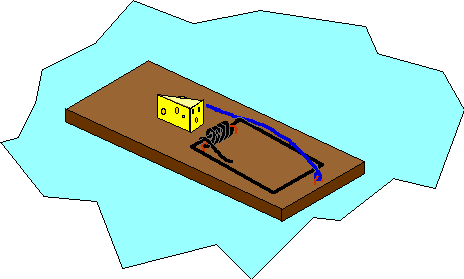
The previous traps have a lot of upward force on the leftmost staple, which might eventually work its way out. Eliminating that staple saves a little on the cost of the trap and may increase its useful life.
이전의 덫은 제일 왼쪽의 스테이플러 심에 위쪽으로 힘이 많이 실리게 되어, 결국에는 심이 빠지게 될 수도 있다. 그 스테이플러 심을 제거하여 덫을 제작하는 비용도 절감하고, 수명도 늘릴 수 있다.
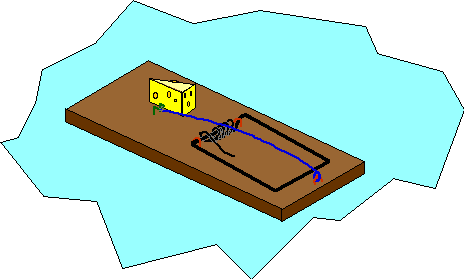
On the previous traps, the only mice that get caught are those that push the hold down bar outward; mice that push it in towards the spring fail to dislodge it. Resting the end of the hold-down bar under the top of a bent-over staple is better; now a mouse that pushes the bar in either direction will trigger the trap.
바로 전에 덫에서, 덫에 걸리는 쥐는 꺾쇠를 바깥으로 밀어내는 녀석들 밖에는 없다. 철사를 감은 부분 쪽으로 꺾쇠를 미는 쥐는 덫을 작동시키지 못한다. 꺾쇠의 한 쪽 끝을 구부린 스테이플러 심 위에 올려놓는 것으로 나아졌다. 쥐가 어느 쪽으로 꺾쇠를 밀어도 덫은 작동할 것이다.
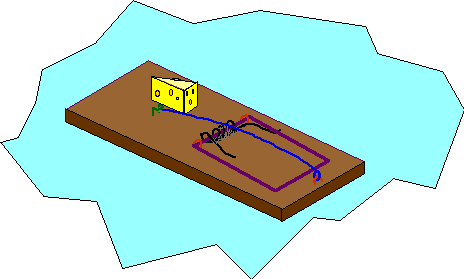
Spring wire is harder to work with than regular wire, and I'll bet it's more expensive, too. Using regular wire for the rectangular hammer and using spring wire only for the spring makes the trap a little cheaper and easier to build. This is an analogy for another way that a seemingly "irreducible" pathway could originate: a single protein that performs two functions could evolve into two proteins, each of which performs a single, necessary function.
감겨있는 철사를 이용하는 것은 일반 철사를 사용하는 것 보다 더 어려울 것이고, 내 생각에는 더 비싸기도 할 것 같다. 일반적인 철사로 직사각형의 해머를 만들고 감겨있는 철사로는 스프링 부분에만 사용한다면, 덫을 만드는 비용이 줄어들고 만들기도 더 쉬워질 것이다. 이는 겉보기에는 "환원 불가능한" 회로가 유래되는 또 다른 방법에 대한 비유이다. 두 가지 기능을 하는 하나의 단백질이 두 종류의 단백질로 진화하여, 각각의 단백질이 하나의 필수적인 기능을 하는 것이 가능하다.
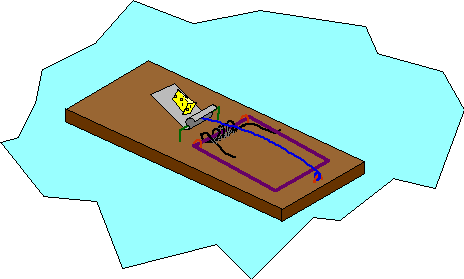
The hold-down bar in the previous traps still required a fair-sized nudge to dislodge it from the bent-over staple. Hooking a clever little catch onto the staple makes it much easier to trigger the trap; any jiggle of the catch releases the hold-down bar, releasing the hammer, and killing the mouse.
전의 덫에서의 꺾쇠를 구부린 스테이플러 심에서 밀어내려면 아직 꽤나 큰 힘이 필요하다. 머리를 좀 굴려서 작은 그릇3을 스테이플러 심에다가 걸쳐놓는다면 덫을 작동시키는게 더 쉬워질 것이다. 그릇이 조금만 움직여도 꺾쇠가 해방되어, 해머가 쥐를 내려쳐 죽일 것이다.
